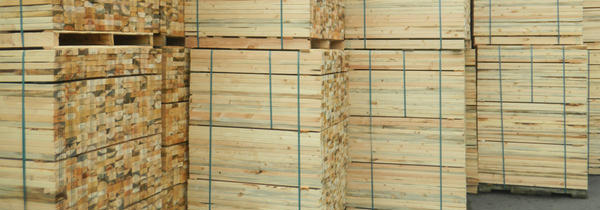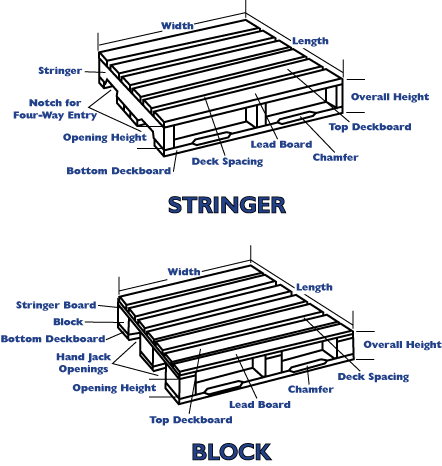Block Pallet vs Stringer Pallet: Which One Is Really Stronger?
Pallet Specs, While many purchasing and shipping managers find themselves in favor of one type of pallet over the other, there are a lot of factors to consider before choosing a block pallet vs stringer pallet for your products. After all, pallets are a critical element responsible for safeguarding your products, making them easy to move, and keeping your production lines running. Pallets are the foundation of your unit load, whether you’re shrink wrapping them, strapping them, shipping them, or simply storing them.
In fact, wood pallets are such a vital part of the supply chain that choosing the correct pallet design can make or break (literally) your shipments and storage.
Fortunately, there are two basic choices: block pallet vs stringer pallet.
What is a Block Pallet? [ Pallet Specs ]
The block pallet gets its name from the blocks that form its base. There are typically 9 blocks in a block pallet, with a solid wood block placed in each of the four corners, in the center of each side of the pallet, and in the center of the pallet itself to support the unit load.
A block pallet is also known as a “four-way” pallet because the tines of a pallet jack or forklift can access and lift it from all four sides of the pallet. Block pallets can be designed with or without bottom deck boards.
Block pallets are commonly thought to be stronger and more durable than stringer pallets because they utilize both parallel stringers and perpendicular blocks. Still, as you’ll see from the head-to-head test below, that’s not necessarily true.
What is a Stringer Pallet? [ Pallet Specs ]
Stringer pallets are the most commonly used pallets in the United States and are so named because they use stringers to support the unit load. Stringers are the boards sandwiched between the top and bottom deck boards and are typically made out of 2 x 4’s or 3 x 4’s.
Stringer pallets are generally considered “two-way” pallets, meaning a forklift or pallet jack can only access them on two sides. Still, stringer pallets can be notched (for a forklift) or chamfered (for a pallet jack) on the non-accessible sides to allow for four-way entry. Although the most common size for a stringer pallet is 48” x 40”, they can be designed to virtually any size.
Which Pallet Type Is Best For Your Application?
There are several considerations when choosing between a block pallet design and a stringer pallet design. Here are a few of the things you should think about.
1. What product is being shipped?
Different products require different specifications for both shipment and storage. For example, pallets for the food & beverage industry have different requirements than pallets used to ship automotive parts. Some products require the pallets to be treated against mold or pests, while that’s not necessary for others.
In addition, some industries require specific pallet sizes and may require either block or stringer pallets for transport. If you’re unsure if a particular pallet size is required for your products, look at the International Organization for Standardization (ISO) for clarification.
Lastly, your product may require a particular wood material for your pallets. While most pallets are made from southern yellow pine, heavier products may necessitate the use of hardwoods, and certain industries prefer pallets made from other woods.
2. Where is the product being shipped?
Where your product is being shipped is a major consideration when deciding between block pallet and stringer pallet design. While stringer pallets are the most commonly used in the United States, other countries use block pallets more commonly.
Additionally, different countries have different standard-sized pallets. While the standard pallet size is 48” x 40”, the same is not true in many other countries. You may also want to consider any specific size requirements for your product’s destination. For example, will it need to fit through a standard doorway or will a forklift be available when your products get to their destination?
3. What’s the weight of the product being shipped?
Whether you choose a block pallet vs a stringer pallet, it must be capable of supporting the weight of your product. Sometimes, a custom pallet design is the only way to ensure that your product’s weight will be properly supported.
4. What kind of strain will the pallet be under?
Often the strain a pallet must endure isn’t evaluated until there’s a failure. Still, you should consider it as you decide whether you want to use a block pallet vs a stringer pallet.
Determining What Pallet You Need
- What kind of shipping and handling conditions will be applied to your pallets?
- Are your products shipping long distances or even overseas?
- Will they be transferred more than once during transit?
- How will they be transferred – forklift, pallet jack, etc.?
- Will the pallets be used multiple times or just once?
- Will they be stored indoors or outdoors?
- Will consumers be exposed to your pallets (like at a warehouse store)?
As you can see, there are many things to consider when choosing the right pallet for your products. Be sure to think it through before you make a decision.
The Socal Pallet Team can help you select the correct pallet for your application.
The formula for Calculating BOARD FEET
FBM =BOARD FEET = (Thickness x Width x Length) / 12
( Inches x Inches x Feet ) / 12

